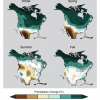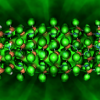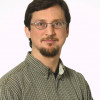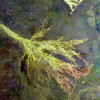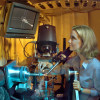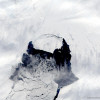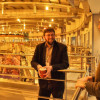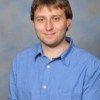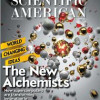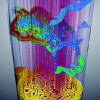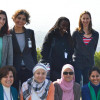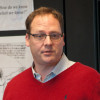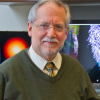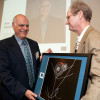News Center
Confirmed: Stellar Behemoth Self-Destructs in Type IIb Supernova
For the first time ever, astronomers have direct confirmation that a Wolf-Rayet star died in a violent explosion known as a Type IIb supernova. Using the iPTF pipeline, researchers caught supernova SN 2013cu within hours of its explosion. These observations are providing valuable insights into the life and death of the progenitor Wolf-Rayet. These stars are interesting because they enrich galaxies with the heavy chemical elements that eventually become the building blocks for planets and life. Read More »
Berkeley Lab Climate Scientist: More Extreme Heat and Drought in Coming Decades
By the end of this century climate change will result in more frequent and more extreme heat, more drought, and fewer extremes in cold weather in the United States. Average high temperatures could climb as much as 10 or more degrees Fahrenheit in some parts of the country. These are some of the projections made by Berkeley Lab climate scientist Michael Wehner and his co-authors on the National Climate Assessment (NCA). Read More »
To Bridge LEDs’ Green Gap, Scientists Think Small…Really Small
Nanostructures half the breadth of a DNA strand could improve the efficiency of light emitting diodes (LEDs), especially in the “green gap,” a portion of the spectrum where LED efficiency plunges, simulations at the U.S. Department of Energy’s National Energy Research Scientific Computing Center (NERSC) have shown. Read More »
CRD’s John Shalf Discusses Big Data with White House Staff
John Shalf, head of CRD’s Computer and Data Sciences Department, was one of four national lab representatives to meet with President Obama’s chief of staff and members of the Office of Science and Technology Policy (OSTP), Office of Management and Budget (OMB) and other agencies to discuss the intersection of big data architecture requirements and exascale challenges. Read More »
Human-induced climate change reduces chance of flooding in Okavango Delta
Researchers at the University of Cape Town, Berkeley Lab and the United Nations Development Programme have analyzed how human-induced climate change has affected recent flooding in an ecologically and geographically unique river basin in southern Africa—the Okavango River. After running a number of simulations, they found that greenhouse gas emissions have substantially reduced the chance of the floods in the region. Read More »
A New Mathematics for Experimental Science
In the age of high-resolution detectors and international research collaborations, math has the potential to transform science and accelerate discovery. But this work will require state-of-the-art mathematics, carefully crafted in inventive new ways. That’s where the Department of Energy’s new Center for Applied Mathematics for Energy Research Applications (CAMERA) comes in. Read More »
Simulations Shed Light on Pine Island Glacier’s Stability
The rapid retreat of Antarctica’s Pine Island Glacier has perhaps reached a point of no return, say three international modeling teams who ran a number of simulations to model the glacier’s behavior. To do this work, they relied on three different ice-flow models including BISICLES, which was developed by a collaboration that included Berkeley Lab computational scientists. Read More »
Seeing the Great Lights of Europe: A Study in Approaches to Synchrotron Data Management and Analysis
Last month, David Brown and Craig Tull of the Computational Research Division (CRD) and Alex Hexemer of the Advanced Light Source went on a 10-day tour of Europe's light sources. Their stops included, Garching, Karlsruhe, Villigen, Hamburg and Oxford. Read More »
CRD, NERSC Staff Present at SIAM Conference on Parallel Processing for Scientific Computing
Dozens of scientists from Berkeley Lab’s Computational Research and National Energy Research Scientific Computing divisions are presenting their research this week at the Sixteenth Conference on Parallel Processing for Scientific Computing. Read More »
Saye and Sethian’s Bubble Visualization Honored by 2013 Visualization Challenge
A visualization created by Berkeley Lab mathematicians Robert Saye and James Sethian of soap bubbles bursting and reforming has won honorable mention in the 2013 International Science and Engineering Visualization Challenge, sponsored by Science magazine and the National Science Foundation. Read More »
Edison Early Users Deliver Results
Two Berkeley Lab computational researchers were among those who pushed the limits of NERSC's new Edison supercomputer while making advances in their fields. Read More »
Berkeley Lab Mathematicians Develop Framework for Nanocrystallography Analysis
Jeffrey Donatelli and James Sethian develop mathematical tools to improve the reconstruction of images in the emerging field of X-ray nanocrystallography. Read More »
Catching Turbulence in the Solar Wind
With help from Berkeley Lab's computational scientists and visualization experts, astrophysicists can now study turbulence in unprecedented detail, and the results may hold clues about some of the processes that lead to destructive space weather events. Read More »
Collaboration Shines in Materials Project Success
At Berkeley Lab, Computing Sciences’ world-class talent and resources have combined to help grow the Materials Project into a "world-changing idea," as it was proclaimed by Scientific American's December 2013 issue. Read More »
Lab Hosts Scientific Computing Day
On December 11, Berkeley Lab hosted Bay Area Scientific Computing Day (BASCD)—an annual one-day meeting to foster interactions and collaborations between researchers in the fields of scientific computing, computational science and engineering from the San Francisco Bay Area. Read More »
Big Data Hits Beamline
When scientists from around the world visit Dula Parkinson’s microtomography beamline at Lawrence Berkeley National Laboratory’s Advanced Light Source, they all want the same thing: scientifically illuminating X-ray views of matter. Unfortunately, many of them have left with debilitating data overload. Department of Energy scientists like Parkinson are collaborating with computational scientists and mathematicians on data-handling and analysis tools. Read More »
Berkeley Lab Hosts 5 Emerging Leaders During TechWomen 2013
TechWomen 2013 brought 76 women from 16 Middle Eastern and African countries to the U.S. in October for a five-week professional mentoring program. TechWomen is an international exchange designed to empower, connect and support women professionals in science, technology, engineering, and mathematics (STEM). This is the third year the Lab has been represented in the program. Read More »
Machine Learning Workshop
As part of the Computational Research Division’s strategic emphasis on increasing the role of computation in all aspects of scientific discovery, CRD staff organized a one-day workshop on Machine Learning for Science. The meeting was held Nov. 4 at Berkeley Lab. Read More »
Scientists See Better Climate Models, Warmer Future
Computational Researcher Michael Wehner was lead author on the newly released IPCC report’s chapter on long-term climate change projections. Among the conclusions were: most continents will continue to warm. Rain and snowfall patterns will continue to shift worldwide. Read More »
Applying the Magic of Mathematics to Solve Problems Using Supercomputers
As part of DOE's focus on supercomputing in September, CRD Director and applied mathematician David Brown answers five questions on how math makes supercomputers even more powerful tools for scientific discovery. Read More »
Berkeley Researcher Applies Graph Theory to Biofuels Research
With support from a DOE Early Career Award, Berkeley Lab Computational Researcher Aydın Buluç will develop faster and more energy-efficient data-mining algorithms in the quest for new biofuels. Read More »
OpenMSI: A Science Gateway to Sort Through Bio-Imaging’s Big Datasets
Mass spectrometry imaging technology is already helping doctors to better diagnose diseases, and leading to the creation of energy efficient and renewable biofuels. But researchers envision these areas of science progressing much faster—if only they had a standard set of computational tools to easily process, analyze and share these massive datasets. Now, they do—it’s called OpenMSI. Read More »
2013 Simons Institute Research Fellow: Sang-Yun Oh
As the first Simons Institute Research Fellow at Berkeley Lab, Sang-Yun Oh will be working with the Future Technologies Group to develop large-scale data analysis methodologies and algorithms. Read More »
Arie Shoshani Earns Berkeley Lab Lifetime Achievement Award
The leader of Berkeley Lab’s Scientific Data Management Research Group, Shoshani was honored at an Aug. 8 ceremony with the Berkeley Lab Prize for Lifetime Scientific Achievement. Read More »
Throwing a Lifeline to Scientists Drowning in Data
New computational techniques developed at Lawrence Berkeley National Laboratory (Berkeley Lab) may help save scientists from drowning in their own data. Computational scientists at the Lab have figured out how to streamline the analysis of enormous scientific datasets. The analysis uses the same techniques that make complex subway systems understandable at a glance. Read More »










